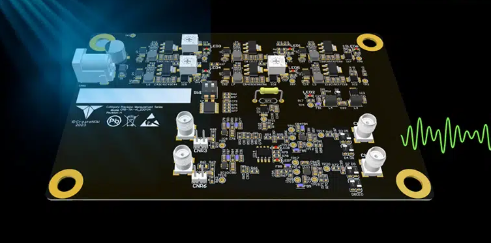- Ameya360 Component Supply Platform >
- Trade news >
- What is the function of transimpedance amplifier?
What is the function of transimpedance amplifier?
The Transimpedance Amplifier (TIA) stands as a cornerstone in modern electronics, a quiet hero behind the scenes, enabling the transformation of minuscule current signals into meaningful and measurable voltage outputs. Its role extends across diverse domains, from optical communications to biomedical instrumentation, showcasing its versatility and indispensability.
As technology strides forward, the transimpedance amplifier continually evolves, adapting to ever-changing demands for faster speeds, higher precision, and improved signal conditioning. This article explores the essence and significance of the transimpedance amplifier, shedding light on its types, principles, applications, and pivotal role in shaping various fields of science and engineering.
What is transimpedance amplifier?A transimpedance amplifier is an electronic device used to convert current into a proportional voltage signal. It’s commonly employed in applications involving photodiodes or other similar sensors that generate a current output in response to light or other stimuli.
The primary function of a transimpedance amplifier is to convert this tiny current signal into a usable voltage output. It does so by providing a low-impedance path for the current to flow through, while simultaneously generating an output voltage proportional to this input current.
By using feedback elements like resistors or operational amplifiers, transimpedance amplifiers can accurately convert and amplify these small current signals into measurable voltage signals. They are widely used in various fields such as optical communication, photodetection, medical instrumentation, and many other sensor-related applications.
What are the different types of transconductance amplifiers?Transconductance amplifiers are devices that convert a voltage input into a proportional current output. There are various types based on their implementation and application. Here are a few:
Operational Transconductance Amplifier (OTA): An OTA is a versatile building block used in analog signal processing. It uses an operational amplifier in a configuration where the output current is proportional to the differential input voltage.
Differential Amplifier: This amplifier has two input terminals and amplifies the voltage difference between these inputs. It’s often used in instrumentation and signal processing.
Field-Effect Transistor (FET) Amplifier: FETs can be used to create transconductance amplifiers, particularly in integrated circuits. MOSFET-based transconductance amplifiers are common due to their suitability for IC design.
Voltage-Controlled Current Source (VCCS): It’s a basic type of transconductance amplifier that generates an output current proportional to an input voltage.
Current-Feedback Operational Amplifier (CFOA): This is a specialized operational amplifier where the current, rather than the voltage, is used as the input signal. It’s commonly used in current-mode signal processing.
Translinear Circuit: These circuits are based on exponential devices (like diodes) and produce an output current that’s a function of the logarithm or exponential of the input voltage.
Why do we need transimpedance amplifier?Transimpedance amplifiers serve several crucial purposes in various applications:
Convert Current to Voltage: Many sensors, such as photodiodes or photomultiplier tubes, generate current signals in response to light or other stimuli. Transimpedance amplifiers convert these tiny current signals into measurable voltage outputs, making them easier to process and analyze.
Signal Amplification: They amplify weak current signals. Since the output of sensors like photodiodes is usually very small, amplifying these signals to usable levels is essential for accurate measurement and further processing.
Low-Impedance Conversion: Transimpedance amplifiers provide a low-impedance path for the input current. This prevents loading effects on sensitive sensors, maintaining the integrity of the signal and preventing distortion or alteration.
Noise Filtering: They can help in filtering out unwanted noise. By amplifying the signal and suppressing noise that might be present, transimpedance amplifiers improve the signal-to-noise ratio, enhancing the accuracy of measurements.
Wide Application Range: These amplifiers find application in various fields, including optical communication, medical instrumentation (such as pulse oximeters), laser-based systems, spectroscopy, and many sensor-related applications where precise current-to-voltage conversion is needed.
What are the applications of transimpedance amplifier?

Transimpedance amplifiers find applications in various fields due to their ability to convert current signals into voltage signals accurately. Some key applications include:
Photodetection: In photodiodes or photomultiplier tubes used in cameras, optical communication systems, or light sensors, transimpedance amplifiers convert the tiny current produced by incident light into a measurable voltage signal for image capture or data transmission.
Optical Receivers: They’re integral in fiber optic communication systems, where they amplify the weak current generated by incoming optical signals, allowing for accurate data retrieval and transmission.
Biomedical Instruments: Used in medical devices like pulse oximeters, where they convert the current generated by photodiodes measuring oxygen saturation in blood into a voltage for monitoring and diagnostics.
Spectroscopy and Analytical Instruments: Transimpedance amplifiers help convert the current generated by sensors measuring light absorption or emission in spectrometers, enabling precise analysis in fields like chemistry, environmental science, and material analysis.
Laser Diode Control: They assist in controlling and stabilizing the output of laser diodes by converting their current output into a voltage for feedback control, ensuring consistent performance.
Particle Detectors: In scientific experiments or industrial applications using particle detectors, transimpedance amplifiers convert the current generated by these detectors into measurable voltage signals for analysis.
Sensor Interfaces: They serve as front-end signal conditioning components for various sensors, converting their current outputs into voltage signals suitable for further processing by microcontrollers or other devices.
What is the difference between transconductance and transimpedance amps?Transconductance amplifiers and transimpedance amplifiers serve different purposes and have distinct functionalities:
Transconductance Amplifier:
Input-Output Relationship: Transconductance amplifiers convert a voltage input into a proportional current output. In other words, they measure the change in output current in response to a change in input voltage.
Functionality: These amplifiers are used to control current flow based on voltage inputs. They’re commonly utilized in applications where a varying input voltage needs to control or modulate a current, such as in audio amplifiers, filters, and voltage-controlled oscillators.
Example: Operational Transconductance Amplifiers (OTAs) are a type of transconductance amplifier.
Transimpedance Amplifier:
Input-Output Relationship: Transimpedance amplifiers, on the other hand, convert a current input into a proportional voltage output. They measure the change in output voltage in response to a change in input current.
Functionality: These amplifiers are particularly useful when dealing with sensors that output current signals, like photodiodes or photomultiplier tubes. They convert the tiny current generated by such sensors into measurable voltage signals, amplifying and conditioning them for further processing or analysis.
Example: Used extensively in optical communication systems, biomedical instruments (like pulse oximeters), and various sensors where current signals need to be converted into voltage signals for processing.
How does transimpedance amplifier work?A transimpedance amplifier (TIA) works by converting a current input into a proportional voltage output. It’s commonly used to amplify and convert small current signals from sensors, like photodiodes, into measurable and usable voltage signals. Here’s how it typically operates:
Input Stage: The TIA receives a small current signal from the sensor, such as a photodiode, which is proportional to the incident light or other stimuli.
Feedback Configuration: The TIA employs feedback components, usually a resistor or an operational amplifier in a specific configuration, to provide a low-impedance path for the input current.
Virtual Ground Principle (in operational amplifier-based TIAs): In cases where an operational amplifier is used, the inverting input terminal is often set at virtual ground potential, maintaining it at a stable voltage level.
Conversion to Voltage: The input current flows through the feedback resistor, producing a voltage across this resistor proportional to the input current (as per Ohm’s Law: Voltage = Current × Resistance). This voltage becomes the output of the amplifier.
Amplification and Signal Conditioning: The TIA amplifies this voltage signal to a level suitable for further processing or analysis. The gain of the amplifier, determined by the feedback resistor and the amplifier’s characteristics, determines the extent of signal amplification.
Output Stage: The amplified voltage signal is then available as the output of the transimpedance amplifier, which can be used for various purposes like measurement, analysis, or further signal processing.
How do I choose a transimpedance amplifier?Choosing a transimpedance amplifier (TIA) involves considering several key factors that align with your specific application requirements. Here’s a guideline to help you select the right TIA:
Input Signal Characteristics:
Input Current Range: Determine the range of input currents your sensor or photodiode produces. Ensure the TIA’s input stage can handle this range without saturation or distortion.
Bandwidth: Consider the frequency range of your signal. Choose a TIA with a bandwidth sufficient to process the frequencies you’re dealing with.
Gain and Sensitivity:
Amplification Requirement: Determine the level of amplification needed. Different TIAs offer different gain values, so select one that matches your amplification requirements.
Noise Performance: Evaluate the TIA’s noise specifications, especially for low-level signals. Lower noise figures are crucial for accurate measurement in sensitive applications.
Speed and Response Time:
Bandwidth and Speed: For high-speed applications, choose a TIA with the required bandwidth and response time that aligns with your signal processing needs.
Component and Design Features:
Feedback Components: Assess the type of feedback network used in the TIA. Depending on your application, choose between resistive, capacitive, or hybrid networks.
Input and Output Impedance: Ensure compatibility with your sensor or subsequent stages in your circuit.
Power Supply and Environment:
Supply Voltage: Ensure the TIA operates within your available power supply range.
Temperature and Environmental Conditions: Consider the operating temperature range and environmental conditions if your application involves extreme conditions.
Application-Specific Considerations:
Optical Communication vs. Biomedical: Different applications might require specific TIAs optimized for their use. For instance, optical communication may demand higher speeds, while biomedical applications might emphasize low noise and accuracy.
Datasheet Evaluation:
Review the TIA’s datasheet thoroughly to understand its specifications, performance characteristics, and application notes provided by the manufacturer.
Testing and Evaluation:
If possible, test the TIA in your specific application scenario or review case studies and user experiences to ensure it meets your needs effectively.
ConclusionIn the vast landscape of signal processing and sensor interfacing, the Transimpedance Amplifier stands tall as a fundamental bridge, connecting the world of current-based signals to the realm of voltage-processing circuits. Its ability to convert, amplify, and condition minute current inputs from sensors like photodiodes has revolutionized countless industries.
As we navigate the complexities of modern technology, the TIA remains a steadfast ally, adapting to the growing demands of speed, precision, and reliability. Its significance endures, promising innovation and advancement in fields ranging from telecommunications to medical diagnostics, ensuring that the subtle currents of our world are transformed into actionable and valuable voltage signals. The Transimpedance Amplifier’s legacy persists—a silent champion in the landscape of electronic engineering.
Online messageinquiry
- Week of hot material
- Material in short supply seckilling
| model | brand | Quote |
|---|---|---|
| BD71847AMWV-E2 | ROHM Semiconductor | |
| MC33074DR2G | onsemi | |
| RB751G-40T2R | ROHM Semiconductor | |
| TL431ACLPR | Texas Instruments | |
| CDZVT2R20B | ROHM Semiconductor |
| model | brand | To snap up |
|---|---|---|
| STM32F429IGT6 | STMicroelectronics | |
| IPZ40N04S5L4R8ATMA1 | Infineon Technologies | |
| BU33JA2MNVX-CTL | ROHM Semiconductor | |
| TPS63050YFFR | Texas Instruments | |
| ESR03EZPJ151 | ROHM Semiconductor | |
| BP3621 | ROHM Semiconductor |
- Week of ranking
- Month ranking
Qr code of ameya360 official account
Identify TWO-DIMENSIONAL code, you can pay attention to


Please enter the verification code in the image below:























